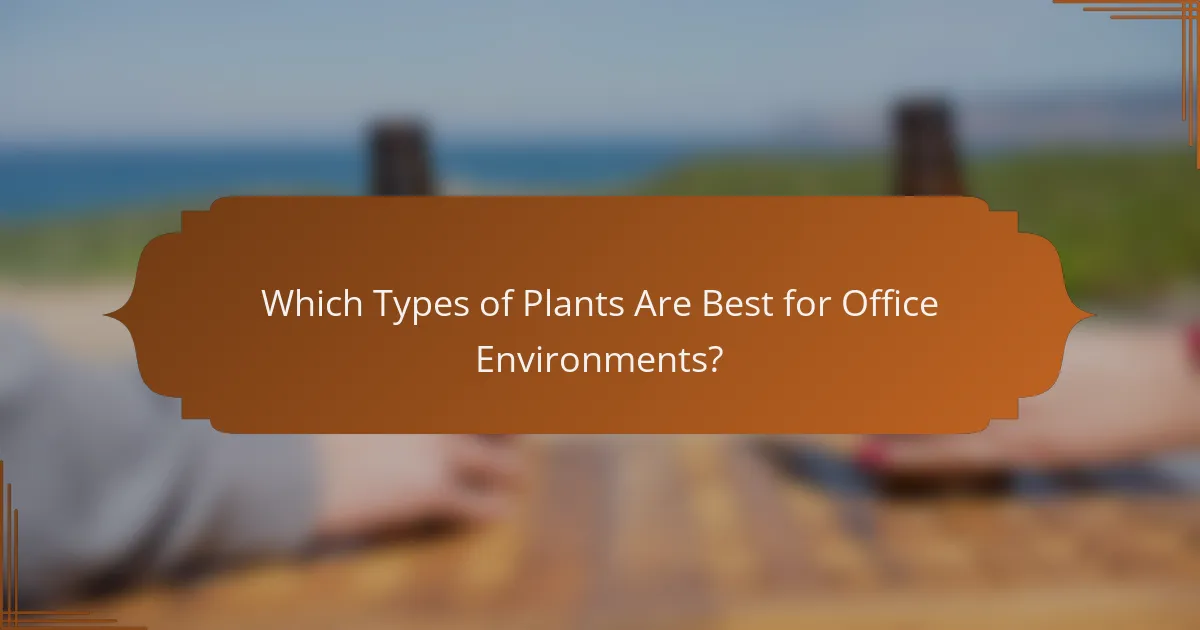Incorporating plants into the workspace offers a multitude of benefits, such as improved air quality, enhanced productivity, and reduced stress levels. By selecting low-maintenance and air-purifying species, offices can create a healthier and more visually appealing environment that fosters employee well-being and morale.

What Are the Benefits of Plants in the Workspace?
Plants in the workspace provide numerous benefits, including improved air quality, enhanced productivity, and reduced stress levels. Incorporating greenery into office environments can lead to a healthier and more stimulating atmosphere for employees.
Improved air quality
Plants play a crucial role in enhancing air quality by absorbing carbon dioxide and releasing oxygen. They can also filter out harmful toxins and pollutants, making the indoor environment healthier. Common office plants like spider plants and peace lilies are known for their air-purifying capabilities.
To maximize air quality benefits, consider placing several plants throughout the workspace. A good rule of thumb is to have one plant for every 100 square feet of office space.
Enhanced employee productivity
Introducing plants into the workplace can significantly boost employee productivity. Studies suggest that the presence of greenery can increase focus and concentration, leading to better performance on tasks. Employees often report feeling more energized and motivated in plant-rich environments.
To leverage this benefit, choose low-maintenance plants that require minimal care, allowing employees to enjoy their presence without added stress. Consider options like pothos or snake plants, which thrive in various lighting conditions.
Reduced stress levels
Plants have been shown to lower stress levels in the workplace. The presence of greenery can create a calming atmosphere, helping employees feel more relaxed and less overwhelmed. This reduction in stress can lead to improved mental health and overall job satisfaction.
Incorporating plants into break areas or meeting rooms can provide employees with a peaceful retreat during busy workdays. Even small desk plants can contribute to a more serene environment.
Increased creativity
Having plants in the workspace can stimulate creativity and innovation. Natural elements in the office can inspire new ideas and enhance problem-solving abilities. Employees often feel more open to brainstorming and collaboration when surrounded by greenery.
To foster creativity, consider creating a dedicated green space or a plant wall where employees can gather and share ideas. This not only encourages teamwork but also enhances the overall aesthetic of the workspace.
Better aesthetics
Plants improve the visual appeal of any workspace, making it more inviting and pleasant. A well-decorated office with greenery can leave a positive impression on clients and visitors. Additionally, a visually appealing environment can enhance employee morale.
When selecting plants for aesthetics, consider a mix of sizes and types to create visual interest. Use decorative pots and arrange plants in a way that complements the office design, ensuring they fit seamlessly into the overall decor.

Which Types of Plants Are Best for Office Environments?
Plants that thrive in office environments typically include low-maintenance varieties, air-purifying species, flowering plants, and succulents. Choosing the right type can enhance aesthetics, improve air quality, and boost employee morale.
Low-maintenance options
Low-maintenance plants are ideal for busy office settings where employees may not have time for extensive care. Options like pothos, snake plants, and ZZ plants require minimal watering and can tolerate varying light conditions.
These plants can thrive in indirect sunlight and only need watering every couple of weeks, making them perfect for those who may forget regular plant care. Additionally, they can adapt to different humidity levels, which is often a challenge in office environments.
Air-purifying plants
Air-purifying plants help improve indoor air quality by filtering out toxins and releasing oxygen. Popular choices include peace lilies, spider plants, and rubber plants, which can significantly reduce common indoor pollutants.
Incorporating these plants into the workspace can create a healthier environment, potentially enhancing employee productivity and well-being. They are particularly effective in spaces with limited ventilation, as they help to circulate and clean the air.
Flowering plants
Flowering plants add color and vibrancy to office spaces, which can uplift the mood of employees. Varieties such as African violets, orchids, and gerbera daisies are popular for their aesthetic appeal and relatively easy care.
While they may require slightly more attention than low-maintenance plants, their visual impact can make an office feel more inviting. Regular watering and occasional fertilization can help these plants thrive and bloom throughout the year.
Succulents and cacti
Succulents and cacti are excellent choices for offices due to their unique appearance and minimal water requirements. Varieties like jade plants, aloe vera, and various types of cacti can survive in dry conditions and require infrequent watering.
These plants are perfect for desks or shelves, as they can thrive in small pots and do well in bright, indirect light. Their resilience makes them a great option for those who may not have a green thumb, while their diverse shapes and colors can add a modern touch to the workspace.

How Do Plants Enhance the Work Environment?
Plants enhance the work environment by improving air quality, reducing noise, and creating a more visually appealing space. Incorporating greenery can lead to increased productivity and employee well-being.
Noise reduction
Plants can significantly reduce noise levels in a workspace by absorbing sound and creating a more tranquil atmosphere. Their leaves and branches act as natural sound barriers, which can help minimize distractions from conversations and office equipment.
To maximize noise reduction, consider placing larger plants or clusters of smaller plants in areas where sound tends to echo. For example, using tall potted plants near workstations can effectively dampen noise from nearby common areas.
Temperature regulation
Plants contribute to temperature regulation by releasing moisture into the air through a process called transpiration. This natural cooling effect can help maintain a comfortable environment, particularly in warmer climates or during hot seasons.
Incorporating plants like ferns or peace lilies can enhance humidity levels and lower temperatures by a few degrees. Positioning plants near windows can also help block direct sunlight, reducing heat buildup in the workspace.
Visual comfort
Plants improve visual comfort by adding color and texture to the workspace, which can enhance mood and reduce eye strain. A visually appealing environment can lead to increased focus and creativity among employees.
Choose plants that thrive in indoor conditions and require minimal maintenance, such as snake plants or pothos. Strategically placing these plants around workstations or in common areas can create a more inviting and comfortable atmosphere for everyone.

What Factors Should You Consider When Choosing Office Plants?
When selecting office plants, consider light availability, space constraints, and maintenance requirements to ensure a suitable environment for both the plants and your workspace. These factors will help you choose plants that thrive and enhance your office atmosphere effectively.
Light availability
Light availability is crucial when choosing office plants, as different species require varying amounts of light. Assess the natural light in your workspace; for instance, low-light plants like snake plants and pothos thrive in dim conditions, while succulents and cacti need bright, direct sunlight.
To maximize plant health, consider using grow lights if natural light is insufficient. A simple rule of thumb is to place plants near windows or light sources that match their light needs, ensuring they receive the right amount of illumination throughout the day.
Space constraints
Space constraints play a significant role in plant selection, especially in smaller offices. Evaluate the available space and choose plants that fit well without overcrowding the area. Compact plants like peace lilies or small ferns can be ideal for limited spaces.
Additionally, consider vertical gardening options or hanging plants to utilize vertical space effectively. This approach not only saves floor space but also adds visual interest to your office environment.
Maintenance requirements
Maintenance requirements vary widely among plant species, impacting your choice. Some plants, like ZZ plants and spider plants, are low-maintenance and require minimal watering, making them suitable for busy office settings. Others may need more frequent care and attention.
Establish a simple care routine based on the plants you choose. For example, set reminders for watering and fertilizing, and regularly check for pests. This will help maintain a healthy plant environment without overwhelming your schedule.

How Can You Incorporate Plants into Your Workspace?
Incorporating plants into your workspace can enhance aesthetics, improve air quality, and boost employee morale. Simple steps like selecting suitable plants and placing them strategically can create a more inviting and productive environment.
Choosing the Right Plants
Selecting the right plants for your workspace is crucial for ensuring they thrive and contribute positively. Consider factors such as light availability, humidity, and maintenance needs. Popular choices include snake plants, pothos, and peace lilies, which are known for their resilience and air-purifying qualities.
When choosing plants, think about the size of your workspace. Smaller plants like succulents can fit on desks, while larger plants like fiddle leaf figs can serve as statement pieces in common areas. Ensure that the plants you select are non-toxic, especially in environments with pets or children.
Placement Strategies
Strategic placement of plants can maximize their benefits. Position plants near windows to take advantage of natural light, or use shelves and tables to create layers of greenery. Grouping plants can also enhance visual appeal and create a more cohesive look.
Consider the flow of your workspace when placing plants. Avoid obstructing pathways or creating clutter. Instead, use plants to define spaces, such as placing larger plants to separate work areas or using hanging plants to add interest without taking up floor space.
Maintenance Tips
Set reminders for fertilizing plants during the growing season, usually spring and summer, using a balanced fertilizer. Be mindful of pests; inspect plants regularly and take action promptly if you notice any issues. A little attention can go a long way in maintaining a vibrant workspace.
